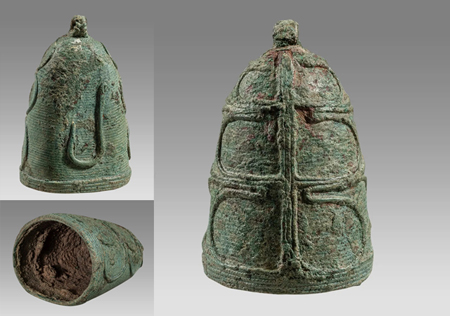
Owner: HWMC
Catalog#: 2AS-IDST-91
Bells
Vietnam ‘Bronze Bell’ (Dong Son)
Vietnam
Dong Son culture
Bronze
ca. 200 B.C.E. to 100 C.E
Height: 3 in; Bell Width: 2 in
Idiophones – Struck Idiophones – Bells
This small bronze bell was cast possibly by the Dong Son culture of Vietnam, ca. 200 BCE. The Dong Son culture or the Lạc Việt culture (named for modern village Đông Sơn, a village in Thanh Hóa, Vietnam) was an ancient Vietnam Bronze Age culture that had been introduced to bronze and the ‘lost wax’ process from the north. This culture also had iron implements, but their production of ritual bronze kettle drums is most notable.
This bronze bell displays a green-turquoise patina, with a raised symmetric rope-like design on the front and on the back a hook design. There is a suspension loop at the top, but there is no clapper inside. The bottom of the bell is decorated with a stacked rope-like design. The shoulders are rounded as the sides flare out. Surviving bronze articles from this culture, oftentimes mention that these bells are found in elite burials, it appears that musical instruments were immensely important to these ancient peoples.
The original Vietnam people were the early Dong Son people. They were known for bringing their sophisticated mining, smelting and casting skills from their Mongolian origins. They have left a legacy of magnificent bronze statues and drums starting with the discovery of a huge number of bronze and other artifacts at the site of Dong Son on the banks of the Ma River in northern Vietnam. Archaeologists believe that the bronze age culture originated in Vietnam and the discoveries made at excavation of further sites across South East Asia, including Cambodia and the Indo-Malaysian archipelago, show that as the culture spread local Neolithic stylistic elements were incorporated.
Resource: https://www.haivenu-vietnam.com/vietnam-culture.htm. – https://www.bada.org/object/dong-son-bells-cambodia-battambang-province
